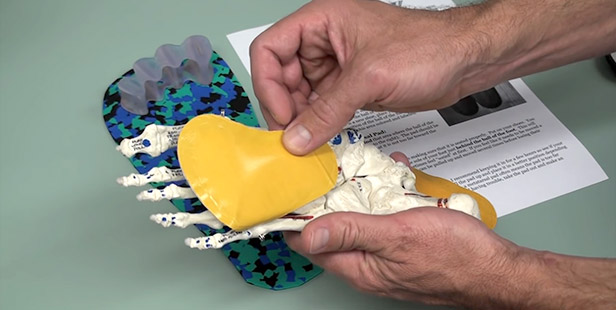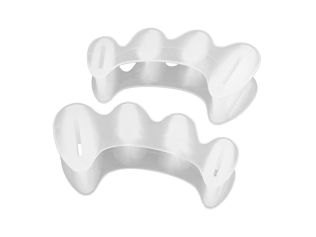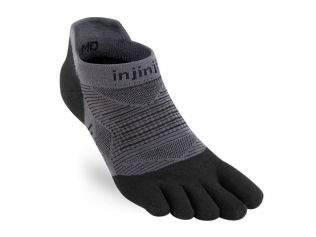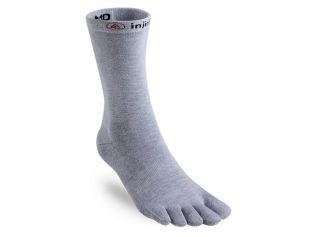T-Form Metatarsal Pads - Pedag
Metatarsal pads are used to reverse the damage from shoes that unnaturally push out the transverse arch of your foot (the arch that runs the width across the ball of your foot). These Pedag t-form metatarsal supports are recommended for use with Correct Toes to optimize the restoration of natural foot shape and function.
Sold in pairs.
Metatarsal foot pads fit behind the ball of the foot and are used to help spread your transverse arch (the arch behind the ball of your foot that runs across the width of your foot), promote the return of any overextended toes to their normal anatomical position, and encourage the return of your forefoot fat pad to a place that supports your metatarsal heads. The use of pads can realign your toes while offering benefits to those dealing with metatarsalgia, arch pain, capsulitis, and neuromas.
- Designed to help restore the natural shape of the transverse arch.
- T-Form shape avoids medial longitudal arch (the big arch that runs along the inner length of your foot).
- Peel-off adhesive back.
- Memory Foam core.
- Made from fine goatskin.
- FREE shipping within USA. Ships free to international destinations when ordered with a shoe.
Positioning Metatarsal Pads
It can be a little tricky to correctly place T-Form metatarsal pads into the footbed of your shoes. One handy tip is to remove the insole of your shoe and stand on it with your bare foot over the pad to easily see how the pads should be positioned. You can then permanently adhere the pad to the insole before re-inserting it into your shoe.
Unfortunately, this will not work with most Softstar shoes since our thin, minimal sole designs rarely include removable insoles (an exception is our Rogue shoes). No worries! Follow these simple steps to place the pads correctly in shoes with non-removable insoles:
1. Get Familiar with How the Pads Should Feel
Before placing a pad in your shoe, first try standing on it with your bare foot on a hard floor. By seeing how the pad is positioned against your foot and understanding how it should feel, you will be better equipped to place it correctly in your shoe.
The biggest mistake people make when placing metatarsal pads is positioning them too far forward or too far back. You should not feel the padding underneath the ball of your foot when your weight is on it, but you also do not want space between the ball of your foot and the pad. If you imagine a curved line along the back edge of the ball of your foot (where the denser area ends), the ideal placement will position the top curve of the metatarsal pad against that line, as shown in this image:
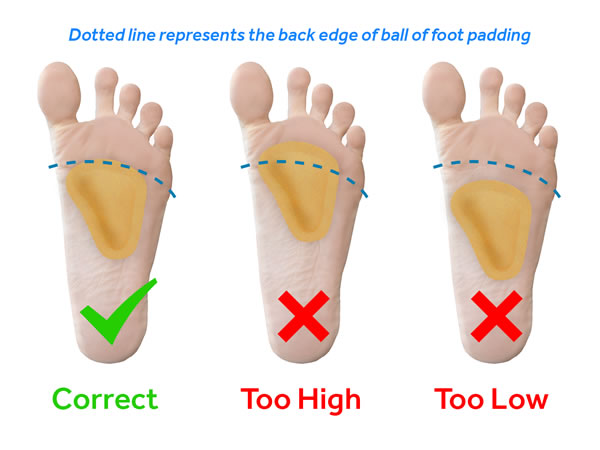
You also want to make sure the thickly padded area of the metatarsal pad does not sit beneath your medial longitudal arch. This is the large arch that runs along the inner length of your foot, and what people usually mean when they talk about foot arches:
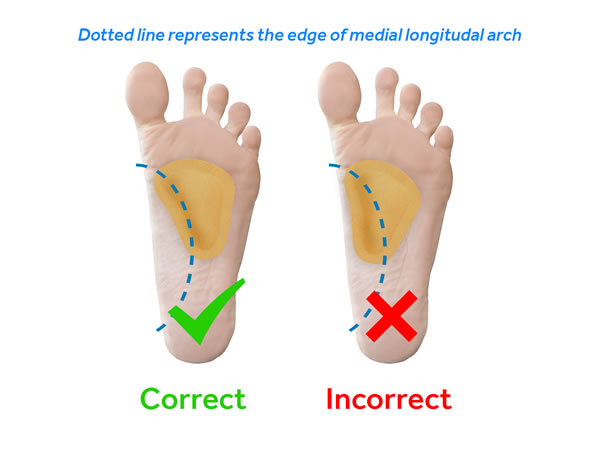
2. Test Non-Permanent Placement in Your Shoe
When you are familiar with how the correct placement should feel against your foot, you can start trying to replicating this positioning in your shoe. The back of the metatarsal pad will peel off to reveal an adhesive surface. This adhesive is very strong and difficult to remove once placed, so we recommend only peeling off a small section, about 1cm, and folding the film back. This will expose just enough adhesive to hold the pad in place in your shoe's footbed while you try it out with your foot in the shoe, but it will also allow you to remove and reposition the pad if it does not feel right. When you walk with the pad correctly positioned in your shoe, you should feel your toes being pulled down slightly.
3. Permanent Placement
When you find the right position within your shoe, it is time to peel off the remainder of the adhesive film and permanently set the pad. If your shoes have laces that you can loosen to pull back the tongue of the shoe (such as Primal or Dash RunAmocs), then you may have enough room to hold the metatarsal pad in place while you peel back the remainder of the film. If that is too difficult with your shoe style, then you can try using a marker to trace or mark positioning points on your insole. You can then remove the pad, peel off the entire adhesive film cover and carefully put the pad back into place while aligning it with the marks you made.
Press down firmly on the pad to secure it into place. All done!
Fortunately, metatarsal pads do not need to be an exact fit to work properly. There is a lot of flexibility in the sizing, so most people will still reap the benefits even if they are off by one size.
If you are using Pedag metatarsal pads with Correct Toes, then please note that these two products are made from different sizing scales. For example, a large Pedag metatarsal pad will correspond with a medium size in Correct Toes. For your convenience, we have added a Correct Toes comparison to this sizing chart:



